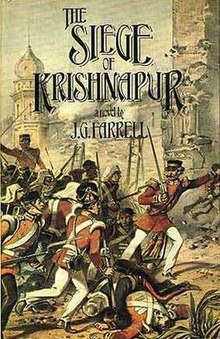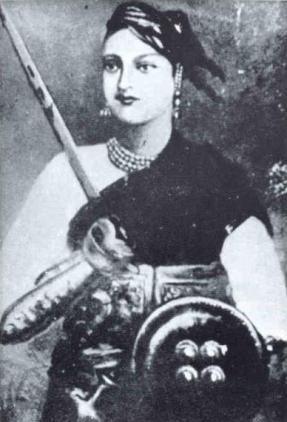
Lakshmibai Newalkar, the Rani of Jhansi or Jhansi ki Rani widely known as Rani Lakshmibai, was the Maharani consort of the princely state of Jhansi in the Maratha Empire from 1843 to 1853 by marriage to Maharaja Gangadhar Rao Newalkar. She was one of the leading figures in the Indian Rebellion of 1857, who became a national hero and symbol of resistance to the British rule in India for Indian nationalists.
Postcolonial literature is the literature by people from formerly colonized countries, originating from all continents except Antarctica. Postcolonial literature often addresses the problems and consequences of the decolonization of a country, especially questions relating to the political and cultural independence of formerly subjugated people, and themes such as racialism and colonialism. A range of literary theory has evolved around the subject. It addresses the role of literature in perpetuating and challenging what postcolonial critic Edward Said refers to as cultural imperialism.

Bahadur Shah II (born Mirza Abu Zafar Siraj-ud-din Muhammad, usually referred to by his poetic title Bahadur Shah Zafar, was the twentieth and last Mughal emperor and a Hindustani poet. He was the second son and the successor to his father, Akbar II, who died in 1837. He was a titular Emperor, as the Mughal Empire existed in name only and his authority was limited only to the walled city of Old Delhi. Following his involvement in the Indian Rebellion of 1857, the British deposed him and exiled him to Rangoon in British-controlled Burma in late 1858, after convicting him on several charges. The title of Empress of India was subsequently assumed by Queen Victoria.

Mary Margaret "Mollie" Kaye was a British writer. Her most famous book is The Far Pavilions (1978).

The Indian Rebellion of 1857 was a major uprising in India in 1857–58 against the rule of the British East India Company, which functioned as a sovereign power on behalf of the British Crown. The rebellion began on 10 May 1857 in the form of a mutiny of sepoys of the company's army in the garrison town of Meerut, 40 miles (64 km) northeast of Delhi. It then erupted into other mutinies and civilian rebellions chiefly in the upper Gangetic plain and central India, though incidents of revolt also occurred farther north and east. The rebellion posed a military threat to British power in that region, and was contained only with the rebels' defeat in Gwalior on 20 June 1858. On 1 November 1858, the British granted amnesty to all rebels not involved in murder, though they did not declare the hostilities to have formally ended until 8 July 1859.

Nana Saheb Peshwa II, born Dhondu Pant, was an Indian aristocrat and fighter who led the Siege of Cawnpore (Kanpur) during the Indian Rebellion of 1857 against the East India Company. As the adopted son of the exiled Maratha Peshwa, Baji Rao II, Nana Saheb believed he was entitled to a pension from the Company. However, after being denied recognition under Lord Dalhousie's doctrine of lapse, he initiated a rebellion. He forced the British garrison in Kanpur to surrender and subsequently ordered the killing of the survivors, briefly gaining control of the city. After the British recaptured Kanpur, Nana Saheb disappeared, and conflicting accounts surround his later life and death.
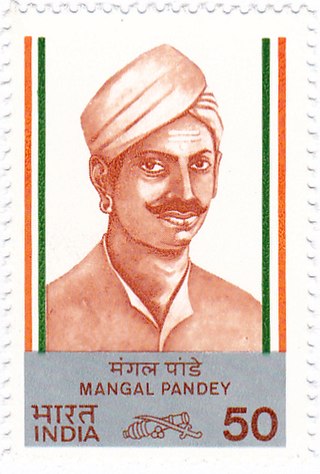
Mangal Pandey was an Indian soldier who played a key role in the events that led to the Indian Rebellion of 1857, which resulted in the dissolution of the East India Company and the beginning of the British Raj through the Government of India Act 1858. He was a sepoy in the 34th Regiment of the Bengal Native Infantry. In 1984, the Republic of India issued a postage stamp in his memory. His life and actions have also been portrayed in several Indian cinematic productions.

The siege of Lucknow was the prolonged defence of the British Residency within the city of Lucknow from rebel sepoys during the Indian Rebellion of 1857. After two successive relief attempts had reached the city, the defenders and civilians were evacuated from the Residency, which was then abandoned.

The siege of Cawnpore was a key episode in the Indian Rebellion of 1857. The besieged East India Company forces and civilians in Cawnpore were duped into a false assurance of a safe passage to Allahabad by the rebel forces under Nana Sahib. Their evacuation from Cawnpore thus turned into a massacre, and most of the men were killed and women and children taken to a nearby dwelling known as Bibi Ghar. As an East India Company rescue force from Allahabad approached Cawnpore, 120 British women and children captured by the rebels were butchered in what came to be known as the Bibi Ghar massacre, their remains then thrown down a nearby well. Following the recapture of Cawnpore and the discovery of the massacre, the angry Company forces engaged in widespread retaliation against captured rebel soldiers and local civilians. The murders greatly enraged the British rank-and-file against the sepoy rebels and inspired the war cry "Remember Cawnpore!".

James Gordon Farrell was an English-born novelist of Irish descent. He gained prominence for a series of novels known as "the Empire Trilogy", which deal with the political and human consequences of British colonial rule.
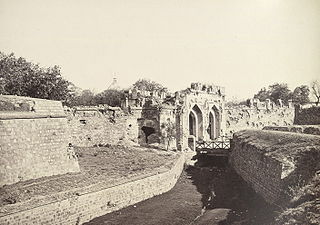
The siege of Delhi was a decisive conflict of the Indian Rebellion of 1857. The rebellion against the authority of the East India Company was widespread through much of Northern India, but was essentially sparked by the mass uprising by the sepoys of the Bengal Army, which the company had itself raised in its Bengal Presidency. Seeking a symbol around which to rally, the first sepoys to rebel sought to reinstate the power of the Mughal Empire, which had ruled much of the Indian subcontinent in the previous centuries. Lacking overall direction, many who subsequently rebelled also flocked to Delhi.
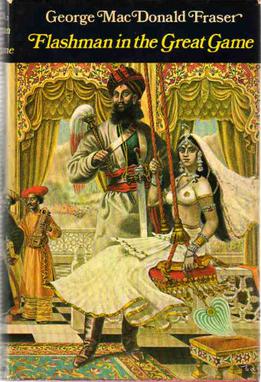
Flashman in the Great Game is a 1975 novel by George MacDonald Fraser. It is the fifth of the Flashman novels.

William Brydon was a British doctor who was assistant surgeon in the British East India Company Army during the First Anglo-Afghan War, famous for reportedly being the only member of an army of 4,500 men, plus 12,000 accompanying civilians, to reach safety in Jalalabad at the end of the 1842 retreat from Kabul.
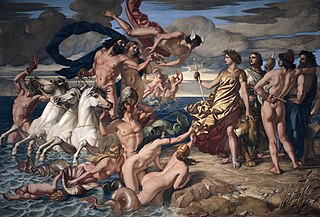
The British Empire has often been portrayed in fiction. Originally such works described the Empire because it was a contemporary part of life; nowadays fictional references are also frequently made in a steampunk context.

Troubles is a 1970 novel by J. G. Farrell. The plot concerns the dilapidation of a once-grand Irish hotel, in the midst of the political upheaval during the Irish War of Independence (1919–1921). It is the first instalment in Farrell's acclaimed "Empire Trilogy", preceding The Siege of Krishnapur and The Singapore Grip. Although there are similar themes within the three novels, they do not form a sequence of storytelling.

The 1915 Singapore Mutiny, was a mutiny of elements of the British Indian Army's 5th Light Infantry in the colony of Singapore. Up to half of the regiment, which consisted of Indian Muslims predominantly from Muslim Rajput background, mutinied on 15 February 1915 due to rumours that they would be sent to fight against the largely Muslim Ottoman Empire as part of the Middle Eastern theatre of World War I. The mutineers killed 36 soldiers and civilians before the mutiny was suppressed by Allied forces. After the mutiny, more than 205 mutineers were tried by court-martial, and 47 were sentenced to execution by firing squad.

The Battle of Badli-ki-Serai was fought early in the Indian Rebellion of 1857, or First War of Indian Independence as it has since been termed in Indian histories of the events. A British and Gurkha force defeated a force of sepoys who had rebelled against the British East India Company. The British victory enabled them to besiege and ultimately capture Delhi.
The Best of the Booker was a special prize awarded in commemoration of the Booker Prize's 40th anniversary in 2008. Eligible books included the 41[A] winners of the Booker Prize since its inception in 1968. The six shortlisted titles were announced on 12 May 2008 and were chosen by novelist Victoria Glendinning, broadcaster Mariella Frostrup and Professor of English at University College London John Mullan. Among the nominees were the only two authors at that time to have won the Booker twice, Peter Carey and J. M. Coetzee, nominated for their novels Oscar & Lucinda (1988) and Disgrace (1999) respectively.
The Lost Man Booker Prize was a special edition of the Man Booker Prize awarded by a public vote in 2010 to a novel from 1970 as the books published in 1970 were not eligible for the Man Booker Prize due to a rules alteration; until 1970 the prize was awarded to books published in the previous year, while from 1971 onwards it was awarded to books published the same year as the award. The prize was won by J. G. Farrell for Troubles.

The Skull of Alum Bheg: The Life and Death of a Rebel of 1857, is a book by Kim A. Wagner, a lecturer on colonial India and the British Empire. It was published in 2017 by C. Hurst & Co., and is based on the life of Havildar Alum Bheg, a sepoy of the 46th Regiment of the Bengal Native Infantry, who following the Indian Rebellion of 1857 and being said to have killed a British missionary family in Punjab, was executed by the British by being blown from a cannon.
